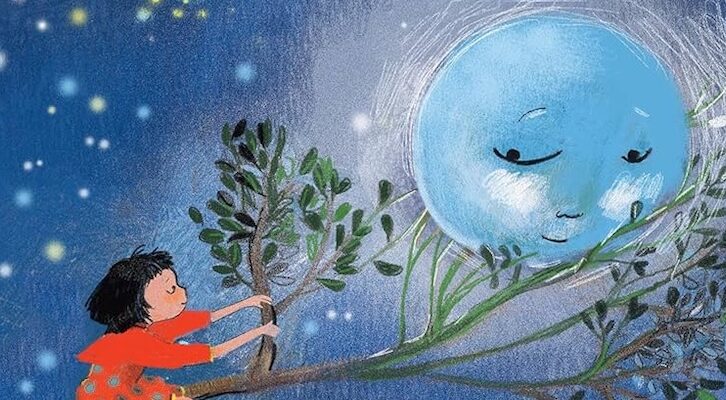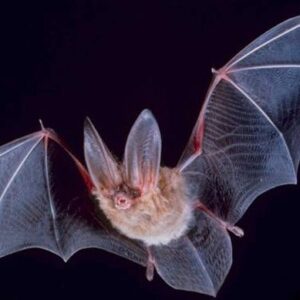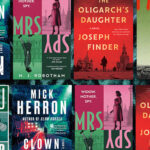
Owls, Haunted Pianos, Having the Moon for a Neighbor: Ten Children’s Books to Read in July
Caroline Carlson Recommends Sue Soltis, Marzena Sowa, Sarah J. Mendonca, and More
I love summer reading, but this summer I’m finding it tougher than usual to make sure my kids are reading, too. They’re just so busy! Their schedules are packed with popsicle-eating, with cannonballing into the city pool, with building blanket forts and grousing about bug spray and riding the park carousel ten thousand times, and I worry that if I gently suggest they open a book, they’ll think I’m giving them homework.
Still, these ten new titles publishing in July are ones that I think my young readers and yours will find time to pick up willingly. They’re enough fun to compete with blanket forts and popsicles, only sneakily educational, and as immersive as the deep end of the pool.
*

Sue Soltis, The Moon Moved In (illustrated Sonia Sánchez)
(Chronicle, July 1)
(recommended for ages 3-5)
Stella wishes that a kid her age would move into the empty house next door, but when a new neighbor finally arrives, they turn out to be even more intriguing than a new playmate. The Moon, tired of “sitting around in space” without anyone to talk to, has decided to come to Earth to plant a garden and chat with the neighbors.
While the Moon is befriending Stella and deadheading begonias, however, its absence from the sky is causing real problems around the world, disrupting the tides and destabilizing the rotation of the Earth.
Sonia Sánchez’s appealing artwork and Sue Soltis’s quirky, thoughtful storytelling make this book a great choice for readers of all ages to admire and share.

Marzena Sowa, The Mixed-Up Owl (illustrated Joanna Lorho) (trans. Jill Davis)
(Hippo Park, July 29)
(recommended for ages 4-8)
I can’t get enough of illustrator Joanna Lorho’s wonderfully funny and expressive artwork in this picture book about an owl who wonders why he seems to be the only one in the forest who has trouble sleeping at night.
When all the diurnal creatures wake up, Owl asks them for tips (or at least he tries), but the bears, turtles, ducks, and spiders aren’t interested in answering Owl’s questions about how they fall asleep. Owl manages to throw the whole forest into an amusing uproar before a drowsy, grumpy porcupine finally helps him understand that not everyone is meant to be a morning person.
The text, translated from French, is presented partly in comics-style word bubbles, and the illustrations of confused, anxious, and increasingly exasperated animals tell a great story in any language.

Lisa Brown, The Moving Book
(Neal Porter Books, July 22)
(recommended for ages 4-8)
When my kids were small, I appreciated picture books that we could read together to prepare for new life experiences like going to the dentist, starting school, or flying on an airplane for the first time. And I really appreciated books about those experiences that were not just useful but also beautiful and fun to read in their own right.
Acclaimed author-illustrator Lisa Brown has a series of excellent picture books in this vein: The Airport Book, The Hospital Book, and now The Moving Book, about a family that has moved many times already and is preparing for one more trip to a new home. The older sibling narrates the story, explaining to a younger sibling what moving has been like in the past and what it might be like this time around as the family prepares to share a new living space with an older relative.
This is a perfect book for any young child preparing for a move, but it’s so colorful and warm-hearted that I think lots of other readers will enjoy it, too.

Wolverton Hill, The Boy Who Became a Parrot: A Foolish Biography of Edward Lear, Who Invented Nonsense (illustrated by Laura Carlin)
(Enchanted Lion, July 29)
(recommended for ages 6-12)
To young readers, Edward Lear is probably most famous for his poem “The Owl and the Pussy-cat,” but Wolverton Hill and Laura Carlin give us a more expansive portrait of the artist in this clever and energetic picture book biography.
In addition to inventing the literary genre of nonsense, Lear was a gifted natural history artist who became particularly famous for his illustrations of birds. Rich and influential adults enjoyed Lear’s company, but Lear himself preferred making mischief for children, telling absurd stories and drawing impossible creatures.
Hill’s text sometimes forays into Lear-like nonsense—when it describes an unusually chatty macaw at the zoo, for example—and Carlin’s art is a fanciful homage to Lear’s own.

Rachel Lancashire, The Atlas of Languages: Words Around the World (illustrated by Jenny Zemanek)
(Abrams, July 22)
(recommended for ages 8-11)
Did you know that Basque language speakers have a useful word, etzidamu, that means “the day after the day after tomorrow?” Or that the English word banana may have its origins in the Wolof language of West Africa?
Like some of my other favorite nonfiction titles, The Atlas of Languages is a visually striking and thoughtfully designed book that presents complex ideas in a kid-friendly way. Full of maps, charts, and linguistic family trees, it’s ideal for curious readers who have questions about the words they use and how different languages around the world are connected.
The book is organized roughly by continent, and each section contains an illustrated map of a region of the world, colorful trees to show relationships among the languages spoken there, and text blocks that share facts, idioms, and fun details about some of those languages.

Sarah J. Mendonca, An Encantadora’s Guide to Monstros and Magic
(Quill Tree Books, July 8)
(recommended for ages 8-12)
I’m excited for readers to discover this magical heist novel set in an inventive, Portuguese-inspired fantasy world where characters have to fend off both creepy monstros and unscrupulous humans. Rosa works as a trapper, catching fire slugs and other pesky magical beasts to scrape together enough money to support her family.
She resents the wealthy members of the corrupt governing Ministério dos Monstros, and when a minister threatens to shutter her family’s Encantadora shop if their unfair dues aren’t paid, Rosa has to find a way to save their livelihood. Fortunately for her, there’s work to be found: a gang of thieves is assembling a crew to steal a precious necklace from the Ministry itself.
Debut author Sarah J. Mendonca combines lots of elements kids love—adventure, magic, and compelling characters—in a story that feels fun and fresh.

Jo Beckett-King, The House of Found Objects (A Bea Bellerose Mystery #1)
Simon & Schuster, July 29
recommended for ages 8-12
Young codebreakers and puzzle enthusiasts will enjoy solving riddles and clues alongside the characters in this new middle grade mystery. Twelve-year-old Bea is spending the summer visiting relatives in Paris, which may sound like a dream to any kid from New Jersey but isn’t going exactly as Bea had hoped.
Her aunt doesn’t have time to take her sightseeing, her cousin Céline is cool and dismissive, and her grandmother, who runs an antique shop, is distraught when a precious family heirloom—a drawing by Matisse—goes missing. But Bea has received a mysterious coded message from a stranger, and she thinks that if she can manage to crack the code, it might lead her to the Matisse.
With Céline’s help, Bea takes off on a twisty treasure hunt around Paris that will delight mystery fans and armchair travelers alike.

Meg Medina, Graciela in the Abyss (illustrated by Anna and Elena Balbusso)
(Candlewick, July 1)
(recommended for ages 10-14)
Fresh from her term as the National Ambassador of Young People’s Literature, award-winning author Meg Medina returns to middle grade readers’ bookshelves this month with a magical new novel. Graciela, who drowned after falling from a seaside cliff when she was only thirteen, is now a sea ghost. She collects bits of bottle glass to polish and scatter on shore, and she helps other drowned souls transition into their own watery afterlives, but she can’t help wondering what she’s missed in the world of the living.
Meanwhile, on land, a boy named Jorge discovers a harpoon that has the power to kill sea ghosts. When he steals it from his unkind parents, he hopes to destroy it—but, naturally, things don’t go as planned.
Jorge’s and Graciela’s stories intertwine in a page-turning illustrated adventure great for read-alouds or read-alones.

Whitney Gardner, Free Piano (Not Haunted)
(Simon & Schuster, July 1)
(recommended for ages 10 and up)
If you found an old synth keyboard on the curb with a sign that promised it wasn’t haunted, you’d take it home, right? That’s what aspiring musician Margot does, partly in hope that it’ll help her connect with her dad, who seems to care more about his own musical career than he does about Margot.
Of course, the piano does seem to be at least a little bit haunted by an ’80s pop star named Vision. Vision knows a lot about making music, and unlike Margot, she also knows a thing or two about the dangers of letting a desire for fame overtake your art. This graphic novel is funny, spooky, heartfelt, and tough to put down.

S. Isabelle, The Great Misfortune of Stella Sedgwick
(Storytide, July 8)
(recommended for ages 13 and up)
I love racing through a great historical romance on a long summer day, and this month I have my heart set on reading S. Isabelle’s The Great Misfortune of Stella Sedgwick. Eighteen-year-old Stella dreams of being a writer and living an independent life; she has no particular interest in marrying.
But Stella lives in London in the 1860s, and the rules and roles for young women, especially young Black women like Stella, are strict. When Stella learns that she is in line to inherit the manor where her mother once worked as a servant, the news seems at first like a stroke of good fortune—but she can only receive her inheritance if she is married.
Soon Stella and her cousin Olivia are navigating high society, looking for suitable matches, and trying to decide what kind of lives and loves they might dare to imagine.
Caroline Carlson
Caroline Carlson is the author of funny and fantastical books for young readers. Her novels have won accolades from the New York Times, the American Booksellers Association, the American Library Association, and Junior Library Guild. Caroline holds an MFA in Writing for Children and lives in Pittsburgh, Pennsylvania with her family. Find her online at carolinecarlsonbooks.com.



















